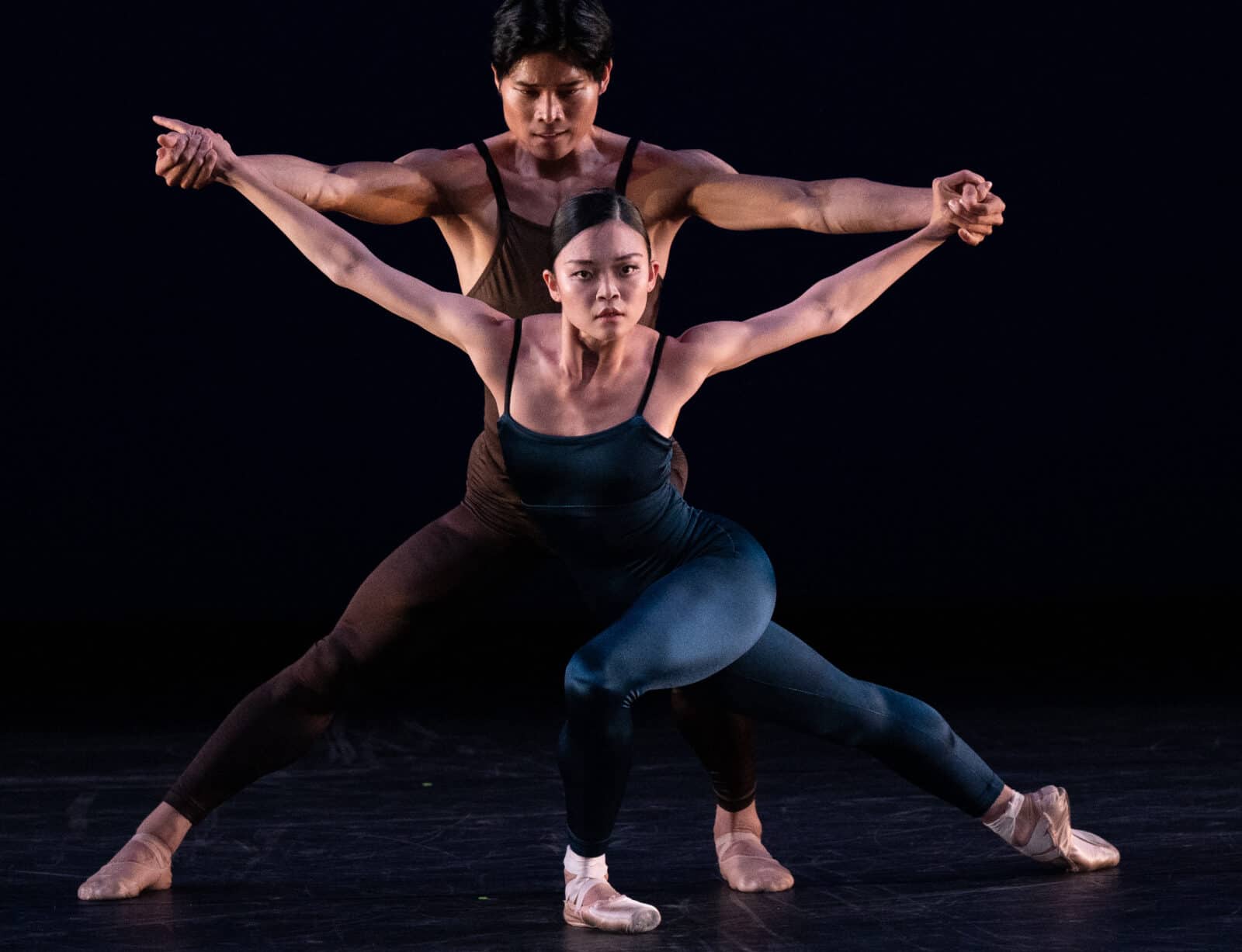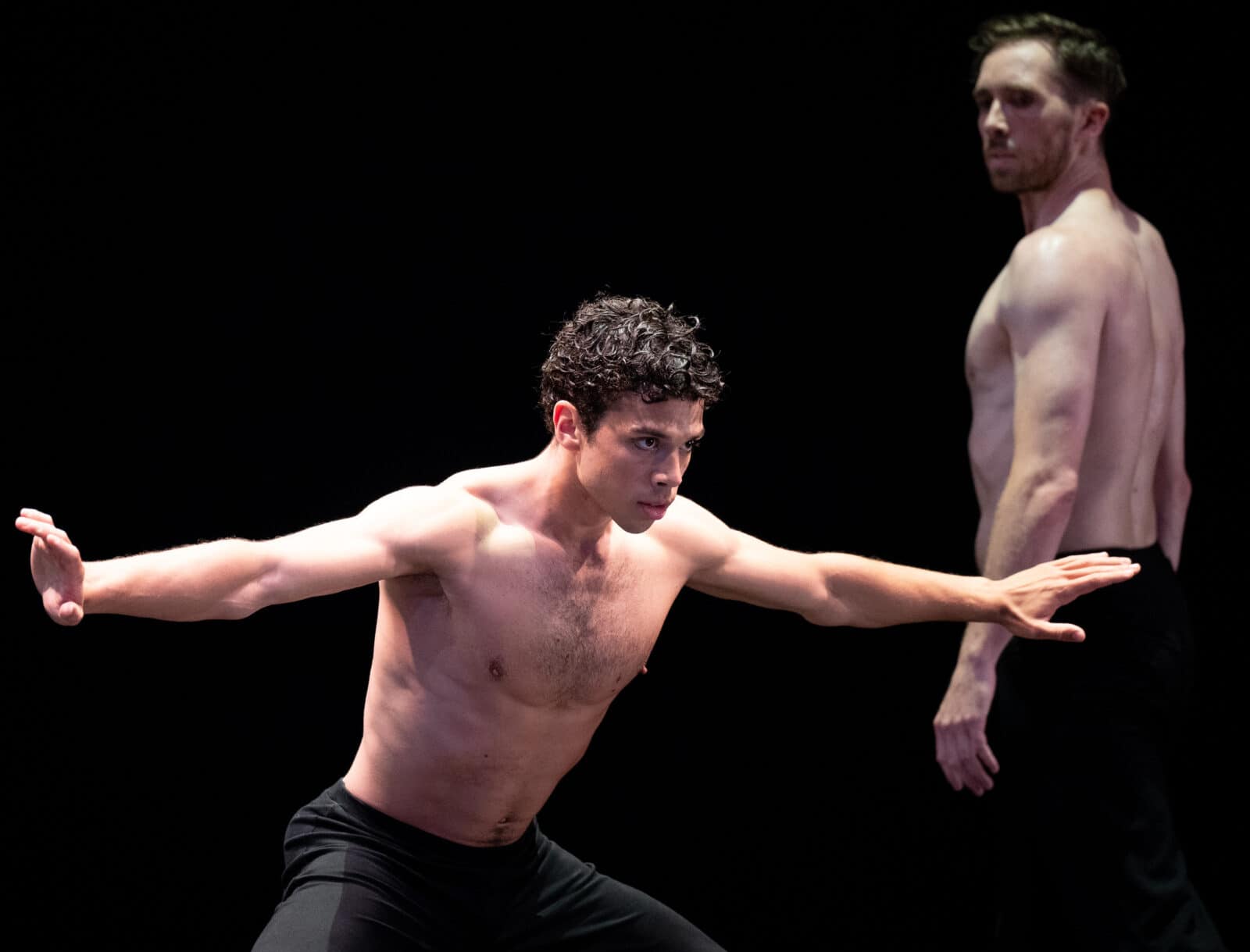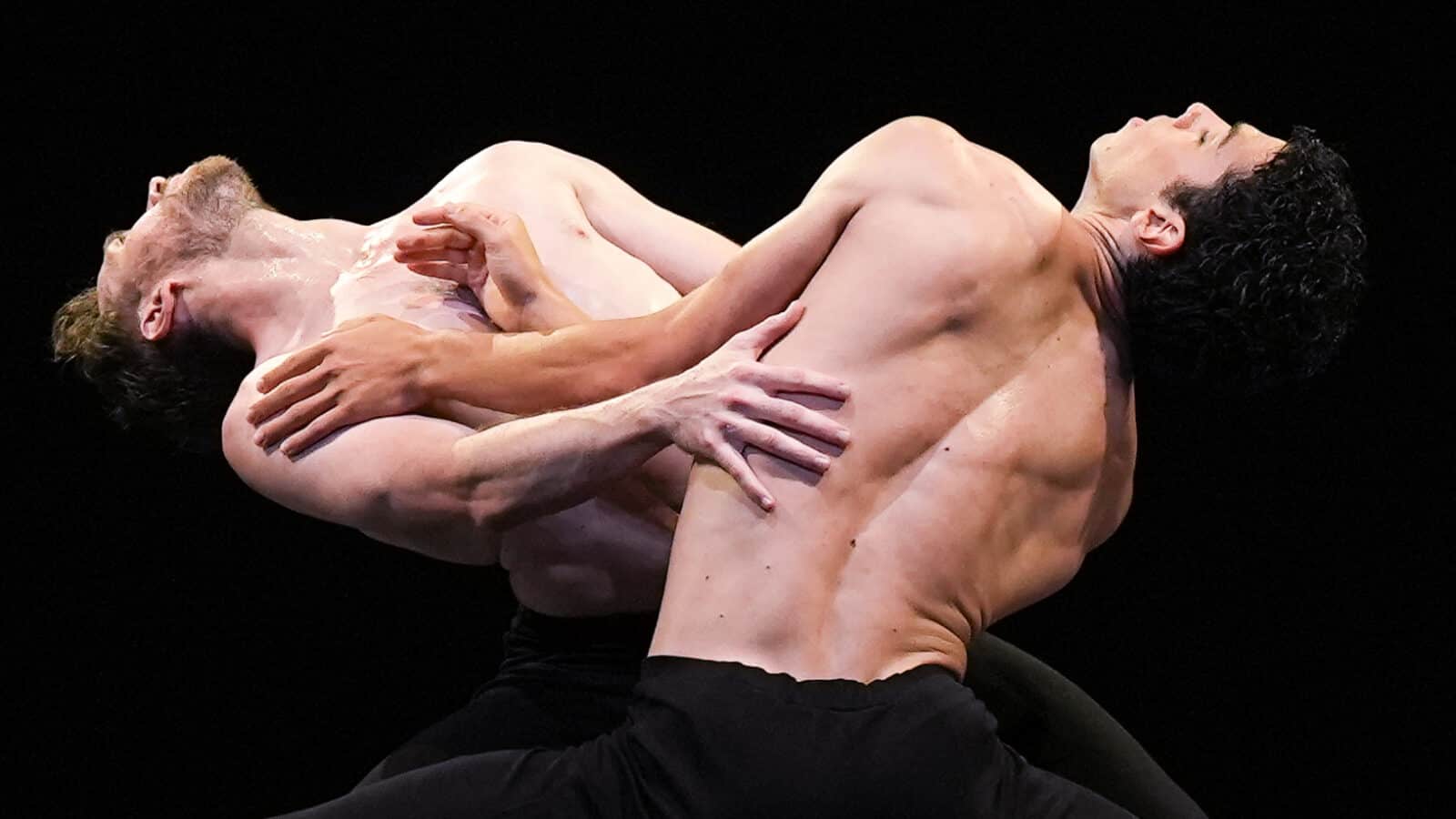A bass voice lingers over low piano chords, and two men take each other’s weight in a fluid, balancing tension.
In the Dutch National Ballet, 80 dancers from around the world come together to explore the power and beauty, form and precision of their art, says associate artistic director Rachel Beaujean — and to hold a wider conversation about how ballet is evolving in the contemporary world.
She spoke from home in Amsterdam, as the company were preparing for their international summer tour. And they’re on their way here. From July 5 to 9, they will perform at Jacob’s Pillow Dance Festival for the first time, in the Ted Shawn Theatre.
They are bringing a wide range of movement, she said — Hans van Manen’s Solo, Five Tangos and Variations for Two Couples, Wubkje Kuindersma’s Two and Only, William Forsythe’s The Vertiginous Thrill of Exactitude and Victor Gsovsky’s Grand Pas Classique.

Young Gyu Choi and Riho Sakomoto perform in Hans van Manen's Variations for Two Couples with the Dutch National Ballet. Press photo courtesy of Jacob's Pillow Dance Festival
She and artistic director Ted Brandsen hope to show the company’s depth, she said, as they perform classics with all of their principle dancers, a contemporary pas de deux, work by emerging artists and internationally recognized choreographers.
“And we have Hans van Manen,” she said.
Globally acclaimed for his clear eye and sense of human connection, van Manen has acted as the Dutch National Ballet’s resident choreographer for more than 50 years, and in that time he has choreographed more than 150 ballets.
His vision has formed the company, Beaujean said — and they celebrate him the way the New York City Ballet performs Balanchine. As the director of the Hans van Manen Foundation, she sets his works everywhere in the world.
“… I know there’s a lot of companies in America that perform his work now, and lately more,” she said. “So we’re very proud of it.”
‘He shapes a world that makes sense, so even when you don’t know anything about ballet you can follow it instinctively, and it’ll lead you.’ — Rachel Beaujean
His influence has deeply informed the company’s signature style, she said in the dancers they choose and repertoire they choose, and also the way they dance, their wide range from classic to contemporary.
His work is abstract, she said, but in the movement and in the energy among the dancers he will make relationships and feelings clear.
“He shapes a world that makes sense,” she said … “so even when you don’t know anything about ballet you can follow it instinctively, and it’ll lead you.”
She has worked with him — and performed with him — since the beginning of one of the works on this summer’s program, the premiere of Five Tangos in 1977.

Qian Liu performs in Hans van Manen's Five Tangos with the Dutch National Ballet. Press photo courtesy of Jacob's Pillow
Van Manen set them to the music of Astor Piazzolla, a globally recognized composer and musician on the bandoneon (a button accordion, kin to a concertina). In his lifetime, Piazzolla was one of the best known composers in his field, Beaujean said, inflecting Argentine music with jazz and classical elements, and now many choreographers have set work on his music — but in 1977, van Manen was the first.
Piazzolla came to perform in Amsterdam soon after the premiere, she said, and she recalls his concert warmly. She and the company met him, and he said he was proud van Manen had chosen his work to make this ballet on, and the work means more to her for that.
It holds a significance in her own life too, she said. She had newly become a principle dancer with the company, and the chance to perform in the new work, and to become part of its creation, has shaped her life since then.
“I was just in the company,” she said. “I was just turned 18 in the summer, and we started to work on Five Tangos right after the holiday. And it was very unusual for somebody to be in their first year and in the corps de ballet of a new creation, and with Hans van Manen … So I was surprised and honored, and it was a big moment for me. And I think he was testing me out.”
She remembers vividly van Manen teaching her a step in rehearsal, a moment that became an exercise in persistence and facing a challenge with courage and calm.
“I think it was the beginning of a long relationship,” she said. “… I think he was testing if he could push me and I would still be trying, and we would make art together. And it started right there with Five Tangos.”
‘I think he was testing if he could push me and I would still be trying, and we would make art together.’
And she felt the power of being in the room where a new work happens.
“Getting to watch a work like that develop,” she said “… I think at the time we all felt, when you’re in the room and the choreography is creating … you know when it’s good. And it was good from the first step.”
At the Pillow, the company will pair Five Tangos with van Manen’s Variations for Two Couples, a work made for very mature dancers, Beaujean said, an understated, subtle work with a diverse choice of music.
“And there’s a beautiful piece of Wubkje Kuindersma’s,” she said. “She’s a Dutch choreographer, so we’re very proud of that, and she’s a woman. She’s made this duet a couple of years ago — and I think it is in some way inspired by Hans the way he looks at dance, but she has her own path. And I think it’s already an evergreen, this pas de deux for two men.”

Timothy van Poucke spreads his arms wide and blocking as James Stout looks over his shoulder in Wubkje Kuindersma's Two and Only with the Dutch National Ballet. Press photo courtesy of Jacob's Pillow
Kuindersma sets new work as a Young Creative Associate with the company, and here she and the dancers are looking deeply into experiences of love and intimacy, in a close and open-ended and nuanced relationship.
“They can be brothers, they can be friends,” Beaujean said. “It’s a very unjudgmental, and … you can watch their relationship develop. I find it’s very, very touching … In the end, it’s about people. This is for me a very emancipated way of doing ballet.
“And that’s the same with Hans van Manen,” she said. “He says, ‘I don’t like romance. I like adventure.’ Or he says things like, ‘Men and women should be equal, because we’re all people.’ … He was always very busy with emancipating people.”
‘He says ‘Men and women should be equal, because we’re all people.’ … He was always very busy with emancipating people.’
Like Ted Shawn at the Pillow, Beaujean said, van Manen has long shown an interest in exploring the movement and range of men dancers, creating situations in the choreography where movements happen freely, without judging.
She recalled a more classical piece he made long ago, where two dancers perform a shoulder sit — one man from another man. The movement happens unexpectedly and fluidly, she said, and it’s a beautiful image, but it was also a point where people were starting to discuss, is that possible? Should we do that? Should ballet go there?
In much of van Manen’s work, she said, partners dance together naturally, without divisions imposed by gender or any other externally imposed category. She sees equalness interwoven in all the choreography, as a base, as a starting point.
An openness of perspectives becomes central to the company’s vision, she said, in the choreography and in the performers — as they lift contemporary voices in a diverse company of dancers.
“We were always a country of choreographers,” Beaujean said, “and the Dutch National Ballet … has now become famous for our classical productions, because we have the stars and we have the level.
“But I was always raised with choreographers, and always being in a creation, and I think that’s also why we have the same wish for classical ballet — to renew itself so it can survive generations.”
‘We have the same wish for classical ballet — to renew itself so it can survive generations.’
And so the company will think carefully about ‘how to perform classical ballet and how to make the stories of classical ballet survive with all the knowledge that we have now,’ she said. Earlier works may come from an era when Western choreographers set stories in countries where they did not know the place or the people.
‘I think with the knowledge of nowadays we can actually adapt those stories and make them relevant for today,’ she said.
She opens a conversation that keeps the beauty of the precision, the form the technique of ballet, but asks clear questions about how that how that technique continues to expand and evolve.
“It originates from love for dance,” she said, “because you want to share the beauty of what you know is out there, is in there — you want to share it with the audience. So in order to do that, you have to make it relevant for today.”


